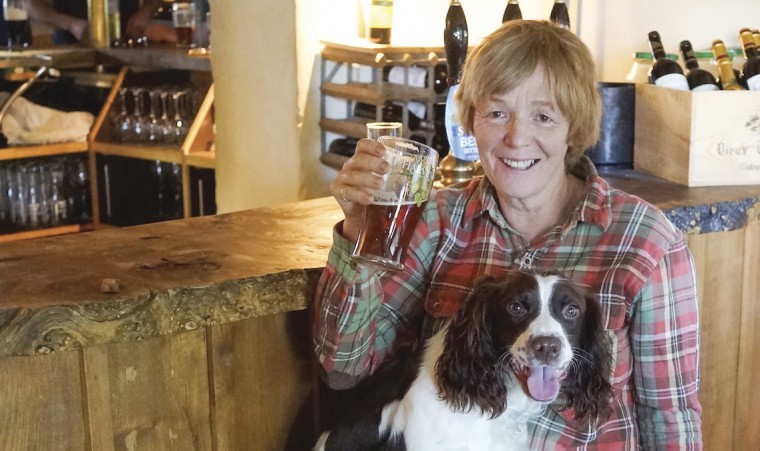It’s great to see our cattle out grazing. Weather permitting, we’re preparing to make extra fodder to see us through next winter. It’s hard to believe that spring calving and lambing is almost over. The cattle gave us very little trouble. Nigel would say that’s the beauty of Sussex cows. In truth lambing did take up more of our attention, but we are now enjoying the spectacle of the lambs running races in the fields.
Our only calving incident was when we suddenly realised that one cow was struggling to deliver. On investigation, the calf was presenting with one leg back. In the rush to sort it, I grabbed a white five litre can, believing it to be lubricant. I dipped in some tubing attached to a 50ml syringe starting to draw it up. I’d planned to place this over the calf inside the cow to ease correcting the calf’s position. The consistency of the liquid wasn’t quite right so I requested a younger family member check the rather faded label. ‘Wash & Wax’ they announced! I discarded the liquid into a bucket which instantly exuded hundreds of bubbles, the scene resembled a foam party rather than a calving. The error was rectified, a healthy calf born, no harm done.
Lambing has gone well, thanks to kind weather and plenty of family help. They gave up their holiday, and were most likely relieved to go back to work for a rest! With the added bonus that they’d gained a suntan. A few sheep characters emerged of note. One ewe, nicknamed ‘Nosey Nora’ was to be found in close proximity to any part of the field where trouble was going on. An incredibly inquisitive character who likes to observe action. This canny ewe tries to disguise her interest, and simply finds the grass where I’m working incredibly tasty! Her stalking tendency is at times alarming. She actually made me nearly drop the eggs while collecting them from the nest boxes, when she crept up behind me. I hope she soon lambs.
Number ninety-eight is a firm favourite, she is a kind hearted soul, who sadly has mastitis. I had to foster one of her lambs away, but I left one with her, and she’s devoted to it. I supplement her lamb with two bottle feeds a day. This is an enjoyable task because her lamb has good hearing, and runs like a greyhound as soon as I call, it guzzles its milk and trots contently back to mum. This lamb likes it’s creature comforts and generally sleeps perched on top of his mother’s wool. I fear it will not be impressed when it comes to shearing time.
Once our lambs are numbered, ringed and bonded well with their mothers they are moved to another farm close by. While ferrying sheep with the mule and trailer, Brie firmly beside me, we observed an interesting sight, which discounts the theory that men are not able to multitask. I passed a local gentleman out exercising his collie, which in itself isn’t remarkable. But in his hand he carried a glass of red wine from which he was sipping. This fascinating sight was worthy of comment, so I drew up along side. He smiled and before I could speak, he stated: “you must think me very decadent.” I declared: “Not at all, in fact I’m most impressed, this is definitely something I aspire to.” I continued on my way while mulling over this new concept, dog walking could take on a whole new meaning, my dogs are less enthusiastic about the prospect, they prefer working.
I took a break from lambing to attend the Pevensey Levels cluster group visit to Elmley nature reserve. This 3,200 acre estate, is on the Isle of Sheppey, a family run farm with approx 700 cattle grazing the marshes that provides a special habitat, especially important for wading birds.
There is a perimeter fence and predators are controlled. We saw lots of lapwing chicks, being guarded by their parents, 350 breeding pairs have been counted this year. We spotted a clutch of four camouflaged patterned eggs, laid in their nest which was little more than a shallow scrape. Lapwings live for seven to eight years. We also saw swifts, swallows, red shank, egret, shoveler, coot, marsh harriers and more.
We looked at the Swale estuary, the marshes are one metre below sea level, the sea wall’s costly maintenance is of ongoing concern. When the tide is out the mud flats provide vital feeding for overwintering birds. Growing on the edge of the estuary is a plant, named hoary cress. This arrived on returning hospital ships during the Crimean war when soldiers bedding was thrown overboard. Sheep will eat it but cattle avoid it.
We saw several hares on these marshes. Hedgehogs are numerous and are trapped because their eating habits aren’t helpful to ground nesting birds. On our way out I saw a pair of barn owls flying around, such a marvellous sight.
An incredibly interesting evening, which confirms my thoughts that country people who have a clear understanding of the balance of nature should be allowed to control predator levels. The result would keep numbers sustainable for the good of all species. No good will come from media hype showcasing the sentimentalists. These ‘do gooders’ do not fully comprehend the detrimental consequences of over protecting certain species.
On a lighter note, this evening I just went outside with milk and bellowed “number ninety-eight”, my husband came scurrying out of the farm buildings, walking down to the house as I fed the lamb he asked. “Did you say dinner is ready?”




